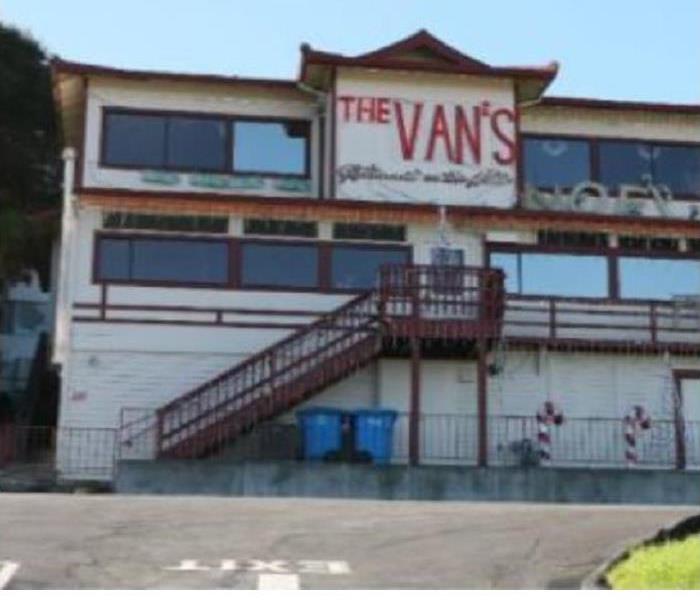Exploring Belmont’s Culture
12/7/2020 (Permalink)
A New Chapter for One of Belmont’s Most Famous Buildings
For over a century, one building in Belmont has stood out from the rest. The Van’s Restaurant on the Hill was, until earlier this year, a beloved local Italian restaurant known for its plentiful portions and excellent service. After almost fifty years of running the restaurant, owner Loring De Martini finally retired in the face of financial uncertainty due to COVID-19.
The building housing this famous restaurant once had a far more impressive claim to fame: it was a centerpiece exhibition at the Panama-Pacific International Exhibition, held in 1915. Less than a decade after the great earthquake of 1906 that destroyed most of the Bay Area, this world’s fair demonstrated the area’s resilience and culture. One of the most noteworthy exhibitions was the Japanese Formosa Tea House. It made such an impression on Belmont native E.D. Swift that he decided to have the whole building brought down from San Francisco by barge. For a time, his daughters used it as a home, but it would soon be sold. After changing owners a few times, the building would eventually be purchased by De Martini, who opted to keep its old name while granting the place some fresh flair.
Now, this century-old building with distinctive Japanese roofing and construction will enter a new phase, as condominiums to help house the town’s ever-growing population. Surprisingly, the building lacks historic designation, but De Martini makes sure that any future owner keeps its unique features intact.
Public Art in Belmont Planned to Expand Over the Next Few Years
Belmont has a long history with public art projects, dating back to its participation in the world’s fair while still being a fledgling community. Today, city leaders plan to keep that tradition alive with evolving plans for public art in parks, streets, and government buildings around the area. Here are just a few of the many focus areas that you can expect to see developing over the next decade, with projects starting to emerge in 2021.
One of the most vital aspects of city planning involves wayfinding or the signs and structures that help people map their way around town. While these planning efforts can be as simple as street signs and speed limits, they also carry many artistic endeavors opportunities. Imagine benches on the side of the road that direct travelers to interesting landmarks or sculptures that signify what part of town in which you find yourself. These artistic emplacements can serve both a pretty and practical purpose, making them a high priority for taxpayer dollars.
Our public park system is the envy of other towns across America, and with expanded allocations for sculptures and other artistic endeavors, its uniqueness only stands to increase. Part of the funding for public art projects will involve contracting a landscape architect and environmental scientist dedicated to creating new, ecologically-friendly exhibits that provide an artistic experience without disrupting nature. The city government expects to have new installations finished in both Twin Pines Park and Water Dog Lake within the next five years.
Some of the most important artistic developments happen not on a commissioned project but in the minds and hearts of unexpected individuals. Recognizing this, a portion of the public art master plan focuses on private installations of sculptures, murals, and architecture. Many future construction elements will be required to dedicate a part of their budgets to artistic features, with the hope of creating a more beautiful face for our community over time. The city hopes to have soon a set of dedicated guidelines and recommendations for individuals and development companies looking to add to the city’s culture in this way.
Initially, most of these plans were expected to begin seeing results as early as this year, but the coronavirus pandemic has unfortunately caused many delays. However, with restrictions easing and business resuming, 2021 appears to be an excellent time for an artist in Belmont.
The Science Behind One of the Most Advanced Mold Removal Companies in Belmont
Without appropriate training and equipment, mold removal from a Belmont home can quickly turn into a disaster. Different species of mold spread across your home in different ways. Without understanding the science behind our detection technology, it may be challenging to assess the risk level in any given part of your house. So, read on to learn a bit about how SERVPRO identifies areas of mold growth and determines potential threats.
One of the latest and most significant pieces of technology we use in our initial inspections has made the identification of fungi a breeze. Infrared imaging devices allow our inspectors to look through walls, floors, and ceilings to find water leaks and elevated moisture areas that can support patches of mold growth. Although we cannot identify an infestation by moisture levels alone, we can figure out where to direct our attention.
Next, we use a variety of different tools to assess the number of fungi in an area. The specific device we use may vary depending on the situation. For example, if we know that a particular type of mold is growing in one area of your house and suspect growth in another room, we may take a quick reading through the wall to determine fungal growth. We may need to take a more detailed reading using air scrubbers that collect spores and analyze them based on their species or genus in other circumstances. Thanks to these tools and many others, we stay two steps ahead of the problem and can help your home with as little time and money spent as possible.
SERVPRO of Belmont / San Carlos is one of the most advanced mold removal companies in Belmont and surrounding areas. Call our 24/7 hotline at (650) 591-4137 for any home damages you encounter.






 24/7 Emergency Service
24/7 Emergency Service